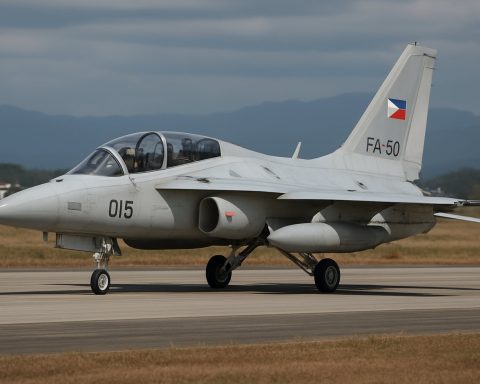- The Philippines is set to acquire 20 F-16 fighter jets from the United States, enhancing its air defense capabilities over the South China Sea.
- This strategic acquisition aims to bolster the Philippine Air Force, augmenting their aging fleet of FA-50PH aircraft.
- The deal emphasizes strengthened military cooperation between the Philippines and the U.S., reinforcing regional alliances.
- China has expressed concerns, viewing this move as a potential threat to regional peace and a challenge to its territorial claims.
- The agreement reflects broader issues of national sovereignty, alliance dynamics, and regional stability in a contentious geopolitical landscape.
- This development signals the Philippines’ commitment to defending its airspace and navigating complex diplomatic relations in the region.
Wings once grounded are poised to soar over the azure waters of the South China Sea as the United States greenlights the Philippines’ ambitious acquisition of 20 cutting-edge F-16 fighter jets. This deal, eagerly awaited in Manila, is far from just a financial transaction. It’s a strategic maneuver amid the high-stakes territorial dispute broiling with China over the contentious maritime expanse.
Visualize the sleek, agile F-16s slicing through the tropical skies, their mission clear: secure the sovereignty of Philippine airspace. For the Philippine Air Force (PAF), these jets add a powerful plume to its aviation tail feathers, vastly improving its capabilities beyond the existing fleet of FA-50PH aircraft—craft effective, but limited in their reach against more formidable adversaries.
The announcement from the US Defense Security Cooperation Agency paints a vivid picture of bolstered maritime vigilance and enhanced air defense, a reassurance not just for the Philippines but for regional allies wary of China’s growing assertiveness. The deal underscores a deepened commitment between Manila and Washington, reinforcing decades of military cooperation.
Yet, every action in this geopolitical chess game echoes over the South China Sea’s turbulent waters. Beijing, monitoring these developments with hawk-eyed precision, has promptly voiced its apprehension. A foreign ministry spokesperson from China articulated concerns over such military enhancements, cautioning against actions that might disturb “regional peace”—a nod to the fine line between deterrence and provocation.
The stakes in this complex saga stretch beyond military might; they encapsulate the broader themes of national sovereignty, alliance dynamics, and regional stability. The Philippines stands at a juncture, balancing its aspirations for self-defense with the nuances of diplomatic strategy—each aerial sortie a part of this intricate dance over disputed waters.
This unprecedented deal is a clarion call to the international community: sovereignty is an enduring pursuit, and in the theatre of modern warfare, skies are no longer the limit but the proving ground.
Philippines’ F-16 Fighter Jet Acquisition: A Strategic Game Changer Amid South China Sea Tensions
Insights into the F-16 Acquisition
The Philippines’ acquisition of 20 F-16 fighter jets marks a significant boost to its air force’s capabilities. The deal, greenlit by the United States, not only strengthens the military alliance between these two nations but also serves as a strategic counterbalance amid escalating tensions in the South China Sea with China.
Enhanced Military Capabilities
How the F-16 Jets Transform the Philippine Air Force
– Technology Leap: The F-16s bring advanced avionics, state-of-the-art radar systems, and greater payload capacity, which are crucial for air superiority.
– Versatility: Known for their multi-role function, F-16s can conduct air-to-air combat, air-to-ground attacks, and intelligence surveillance, dramatically expanding the Philippine Air Force’s operational capabilities.
– Existing Fleet Upgrade: These jets complement the existing FA-50PH aircraft, which, while effective, lack the reach and advanced technologies provided by the F-16s.
Security and Strategic Implications
How This Acquisition Enhances Regional Security
– Regional Deterrence: The presence of these advanced fighter jets serves as a deterrent against potential aggression, particularly in contested maritime regions.
– Alliance Reinforcement: The deal symbolizes a deepened commitment from the United States to support its ally, ensuring a balanced power dynamic in Southeast Asia.
– Stabilizing Factor: With enhanced air capabilities, the Philippines is better positioned to protect its territorial waters, contributing to regional stability.
Controversies and Diplomatic Dynamics
Concerns and Geopolitical Ripple Effects
– China’s Displeasure: The acquisition triggers concerns from China, which perceives it as an escalation potentially disrupting “regional peace”.
– Diplomatic Balancing Act: The Philippines must carefully navigate its defense policies, ensuring strong alliances while managing diplomatic relations with its powerful neighbor, China.
FAQs
What are the main benefits of F-16 jets for the Philippines?
The F-16 jets provide advanced technology, greater operational reach, and versatility, crucial for enhancing the defense of Philippine airspace and maritime territories.
How might this affect the relationship with China?
While it strengthens the Philippines’ defensive capabilities, this acquisition may strain diplomatic relations with China, necessitating careful diplomatic engagement.
What are potential limitations of this deal?
The main limitation is balancing military enhancements with regional diplomatic strategies to maintain peace and avoid unnecessary escalation.
Actionable Recommendations
– For the Philippines: Strengthen diplomatic channels with neighboring countries to reassure them of peaceful intentions while maintaining a robust defense posture.
– For U.S. Allies: Continue collaborative maritime exercises to demonstrate commitment to regional stability and security.
– For Policymakers: Balance defense enhancements with diplomatic efforts to maintain regional peace and stability.
For further insights into military technology and strategic alliances, visit the U.S. Department of Defense.
Conclusion
The acquisition of F-16 fighter jets by the Philippines is a pivotal move in securing airspace sovereignty and strengthening military capabilities. However, it also underscores the intricate balance required in managing regional alliances and diplomatic relations—demonstrating that in modern geopolitics, air superiority is both a strategic asset and a diplomatic tool.







